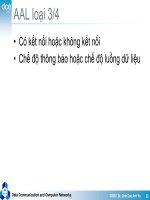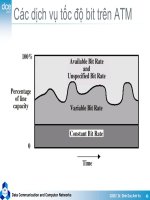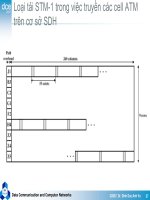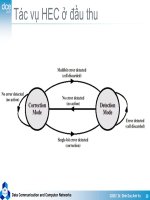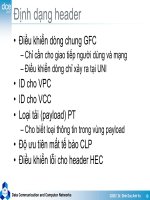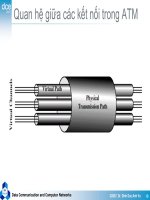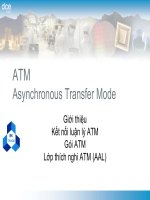Overview (kỹ THUẬT TRUYỀN số LIỆU SLIDE)
Bạn đang xem bản rút gọn của tài liệu. Xem và tải ngay bản đầy đủ của tài liệu tại đây (691.07 KB, 45 trang )
Overview of Data Communication
and Computer Networks
Outline
Data Communication Overview
Definition
Components
Protocols and standards
Network Overview
Connectivity
Categories
Internetworks
2
Motivations
Efficient way to share resources
Cost – less expensive
Accessibility – easier
Efficient way to exchange information
Time – faster
Size – bigger
Correctness – more accurate
3
Data Communication: Definition
Data Communication:
Transfer
Transferof
ofdata
datafrom
fromone
onedevice
deviceto
toanother
anothervia
via
some
someform
formof
oftransmission
transmissionmedium.
medium.
4
Data Communication
Hi,
Hi,
how
how
are
are
you?
you?
Hi, how are you?
Hi, how are you?
Computer
01010001
Click to edit Master text styles
01010001
Second level
Third level
Fourth level
5
User
6
Communications Characteristics
Effectiveness of a data communications system depends on 4
characteristics:
Delivery: correct destination, user…
Accuracy: accurate data reception at destination.
Timeliness: same order without significant delay real-time
transmission.
Jitter: variation in the packet arrival time.
7
Components in Communication
1
Message
Hi, how are you?
5
2
Protocol
Sender
3
4
Receiver
Medium
8
Data Representation
Numbers
8/16/32 bit integers
floating point
150
2
Text
ASCII, Unicode
Images
255
Bit patterns, Graphics formats JPG/GIF/etc
Audio → Samples of continuous signal
Video → Sequence of bitmap images
9
Protocols and Standards
Protocol
A set of rules governing data communications
Syntax: format of data block
Semantics: meaning of each section
Timing: speed and sequencing
Standards
De facto (in practice) standards
→ not approved but widely adopted
De jure (in law) standards
→ approved by an organization
10
Standards Organizations
Creation Committees
ISO, ITU-T, ANSI, IEEE, EIA
Forums
Regulatory Agencies
11
Direction of Data Flow
Simplex: One direction only
data flow
Monitor
Server
data flow
Keyboard
12
Direction of Data Flow
Half Duplex: Both directions, one at a time
data flow at time 1
data flow at time 2
E.g., walkie-talkies
13
Direction of Data Flow
Full Duplex: Both directions simultaneously
data flow
data flow
E.g., telephone
Can be emulated on a single communication link using various methods
14
Networks
Network: a set of devices connected by media links
Laptop
iMac
Workstation
Media Links
Server
SD
Printer
Scanner
15
Types of Connections
Point-to-point
Multipoint (multidrop)
16
Point-To-Point Connection
17
Multipoint Connection
Wireless
18
Topology
Topology: physical or logical arrangement of devices
Point-to-point
Mesh
Star
Bus
Ring
Hybrid
19
Point-to-Point Connection
20
Fully Connected Mesh Topology
E
A
D
B
C
21
Fully Connected Mesh Topology
22
Fully Connected Mesh Topology
Pros:
Dedicated links
Robustness
Privacy
Easy to identify fault
Cons:
A lot of cabling
I/O ports
Difficult to move
23
Star Topology
A
D
Drop
Hub
B
C
Drop
24
Star Topology
A
D
Switch
B
C
25



